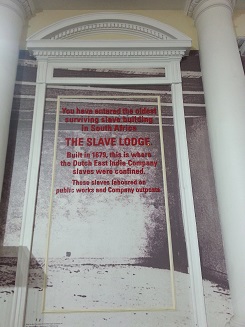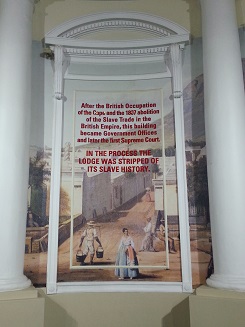Cultural Outings
When not at work, I have been trying to experience as many different facets of the city as possible. I have tried to mix cultural and historical outings with outdoor adventures, and have enjoyed sampling the many culinary and wine offerings of this wonderful city. Toward the beginning of my time in Cape Town the weather was rather uncooperative, so I took the time to explore a couple of the museums. The first one I visited was the District 6 museum. District 6 was a previously vibrant cultural hub which was 85% razed during apartheid as the black tenants were forcibly relocated out of the city center. Interestingly, all these decades later and despite its close proximity to the city, vast swatches of land remain covered in grass and weeds due to an impasse about what to do with the area, an eerie testament to what once was. The museum, situated in the heart of the old neighborhood, recounts the history of this vibrant community before its people were removed and the buildings were torn down by the government as part of their segregation efforts. The museum is housed in an old church, and features a considerable amount of information, as well as photographs from the time and personal accounts of different aspects of community life. It was interesting, though slightly confusing in its layout, often jumping around a bit in terms of time period, location and events, and provided me with a bit more of an understanding of the historical and cultural evolution of the area.
The other museum that I visited was the Jewish Museum, which is partially housed in the first synagogue ever founded in South Africa, with the rest extended into a more modern, but still architecturally impressive building. The old synagogue portion provided more of an overview of Judaism, while the newer portion contained more information about the history of Jews in South Africa—when and where they came from, what they did once here, the establishment of the first Jewish organizations, and some of the most influential Jews in South African history. The museum also discussed the history of anti-Semitism in the country, some of the laws that were passed limiting immigration, where the Jews settled here, and connections to the apartheid/anti-apartheid movement. The Holocaust Centre is next door, and in addition to the Holocaust exhibits, there is a short film about Mandela and the Jews.
I also made the trip out to Robben Island a few weeks ago, a stop than any visitor to Cape Town should make. Passing the time until my afternoon departure, I went through the pseudo-museum in the building where the tickets were sold. I say pseudo because there wasn’t too much there and because I think I am probably one of the few people to ever read all of the boards there. I have a feeling most people just show up and get right on the ferry. But being me, I read every sign in the building, and I found it all to be quite interesting. Some of them described the relationship between the Netherlands and South Africa (especially their stance against apartheid), others looked at objects that were significant to some of the prisoners housed on the island, another looked at the history of a man from District 6, and then downstairs near where you line up for the ferry, they had two walls worth of information discussing the history of the island itself. The information covered the geology of the island (its composition, as well as the fact that it is connected to the mainland and at various times over the millions of years there was no water in between and it was possible to walk from the mainland to what is now an island), the history of the Dutch and Brits who used the island, its long history as a prison, its use as a leper colony, its fortifications during WWII, its transition back to being a prison during the years of apartheid, and finally its transformation into a historical site. Among the many interesting facts that I learned: 1) Robben Island is not named after a person, as many people believe. Rob in Dutch means “seal”, and robben is the plural, so really it is Seal Island. 2) The Dutch sailors, not wanting to have to land on the mainland and deal with trading with the locals, started leaving sheep, rabbits and other creatures on the island so that ships passing by would have access to food. The idea was that they would drop off a scrawny young sheep (so it could live there and fatten up) and they would pick up a fat one and be on their way. They would also hunt the penguins, which is not so cool in my book. 3) They armed the island in anticipation of fighting during WWII. I didn’t really think Cape Town was the hotbed of war activity…4) The prisoners that were housed on the island during the apartheid era had neither beds nor hot water on the island until the late 70s.
After making my way through the museum, it was time for the half hour boat ride out to the island. It was a beautiful day with blue skies and moderate temperatures, and getting to see Cape Town from a different perspective was lovely. When we got to the island they piled us on to two buses for the first part of our two part tour. The bus drove us around the island to show us the lay of the island, while a guide told us a bit of the history and pointed out significant sites. While I thought the idea of the bus tour was excellent, the execution was a bit lacking as the bus set up did not allow for easy viewing of the sites we passed, and the bus did not stop to allow us to explore them on foot. One thing that I was surprised to discover, however, was that there is a functioning town on the island. Mainly comprised of people who care for the island, as well as some former political prisoners, there is a school, a church, a grocery store, etc. And, ironically for a place that houses a former prison, a zero crime rate.
After the bus tour, we were dropped back at the prison where we received a guided tour of the facility by a former political prisoner. For me, that was the most interesting part of the excursion. Having someone with first-hand knowledge explain how things worked on the island—from intake, to the breakdown of prisoners into four distinct groups (that each had different levels of privileges), to the politics, to the differences between the “older” generation of inmates—the ones sent to the island in the early 60s—and the “younger” generation that came in the late 70s and after, to the fact that the criminal prisoners on the island were treated better than the political prisoners—was a fascinating experience. We walked through the various areas of the prison, saw the cell where Nelson Mandela spent most of his time, and got to walk into some other cells that housed objects that were significant to its occupant and a photo and comment about the occupant. It was all very interesting, but we had a limited amount of time, so it was not possible to adequately read all of the information. That would have to be my one critique of the Robben Island Tour—I wished they allowed you to do some of it on your own and to take whichever ferry back later rather than having everything on a set schedule.
More recently I had the opportunity to visit the Slave Lodge in the heart of the city center. The Slave Lodge was originally built as a slave lodge for the Dutch East India Company. It served as such for about 150 years before being converted to government offices, the Supreme Court, etc., and was eventually turned into a museum in the 1960s. The downstairs was really interesting, as it traced the history of slavery in South Africa. Interestingly, while most of the slaves imported to America and Britain were African, most of the slaves in South Africa came from Southeast Asia. Unfortunately I made it there later in the day than I had planned, so I did not have nearly enough time to read all the signs as is my habit, but nonetheless I found it fascinating. Upstairs was more of a hodgepodge of collections, featuring a room of ceramics, another of guns and other weapons, and another of silver. I found a special exhibit on fashion to be quite interesting, as was the exhibit looking at the role of music in the struggle against apartheid.

